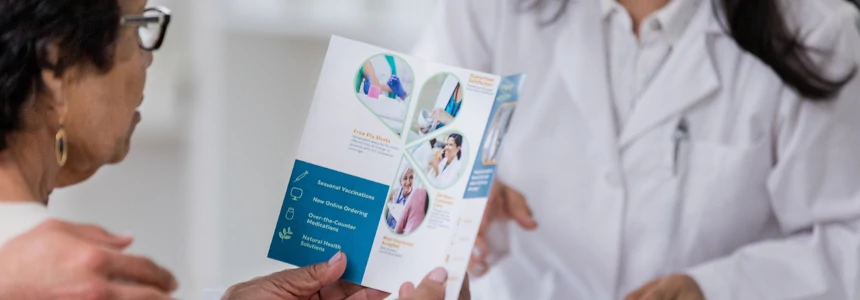In the 20th century, social psychologists seeking to understand human behavior found their efforts complicated by an interesting problem. While the dominant perspectives at the time held that humans learn through direct experience, research indicated that people can learn new behaviors and acquire knowledge, skills, and attitudes indirectly, without experiencing the things themselves. As humans, we are capable of learning from what we observe in the behavior of others, as well as what we see represented in cultural discourses like those that circulate mass media and social media.
Social Cognitive Theory (SCT) is a social psychological theory of behavior conceived by Albert Bandura to explain how individuals learn new behaviors through their interactions with the social world. In the context of health communication, SCT has served as a model for understanding why individuals participate in particular health behaviors, and as a theoretical framework guiding public health promotion initiatives. This article provides an introduction to SCT meant to be useful to prospective graduate students interested in health communication. After briefly surveying the history of SCT, the following sections discuss the model’s key constructs, how SCT has been applied in health communication research, and the state of research employing SCT today.
A Brief History of Social Cognitive Theory in Health Communication
Albert Bandura (1986) developed Social Cognitive Theory as an extension of his previous model of human behavior, Social Learning Theory (SLT), which he innovated with Richard H. Walters two decades prior in 1963. Both of these theories attempt to explain the human capacity to rapidly learn novel behaviors. At the time, the predominant models in social psychology largely failed to take into account social context, with behavioral models focusing on direct, experiential reinforcement of stimuli and cognitive models largely ignoring the role that socialization plays in learning and personality development. Bandura’s model, in contrast, foregrounded the role that socialization plays in the way humans acquire knowledge and behavior. He argued that individuals learn behaviors primarily through observing models of those behaviors in their social relationships with others and through their experiences with culture.
Bandura tested SLT with his famous Bobo Doll Experiment, wherein children were exposed to human models acting aggressively toward anthropomorphic “Bobo dolls.” In Bandura’s original study, children were subject to stressors in order to raise their frustration, and then put in a room with a Bobo doll. Beforehand, the children were divided into groups, with a third observing an adult exhibiting physically and verbally aggressive behavior toward the doll, a third presented with a model of non-aggressive behavior, and a third in a control group where the adult model simply ignored the doll. The results of the study showed a much higher likelihood of developing aggressive behavior in children subject to the violent model.
In two subsequent studies exploring aggression, Bandura found that media models — even cartoon depictions of violence toward the doll — caused a similar response when compared with exposure to live models. Further, children who observed a model of someone engaging in aggressive behavior who faced consequences for their actions were much less likely to emulate that specific aggressive behavior, though they may still learn aggressive behaviors more generally. It is worth noting that these early studies have ethical problems related to the way they expose children to violence and encourage violent behavior in children.
Nevertheless, the central conclusions of these studies regarding the acquisition of novel behaviors through social modeling serve as the backbone of Bandura’s work on Social Cognitive Theory. As its name suggests, SCT has a more cognitive emphasis than SLT, focusing on individual psychological factors that mediate social learning. SCT identifies several key variables — the constructs discussed in the next section — that affect how individuals engage in new behaviors or adapt their existing behaviors, including an individual’s sense of their own abilities with regards to the action, their expectations of the outcome of the behavior, and their perception of the ease or difficulty of taking that action.
While the SCT was not originally designed as a model of health communication, in later research Bandura argued for applying the theory to understanding health behaviors and guiding health campaigns, health education, and media-based public health interventions.
Spotlight on Scholarship - Featured Scholars in Social Cognitive Theory
Learn about contemporary health communication scholars who apply Social Cognitive Theory in their research in a variety of contexts, from the influence of mass media and journalism on health behaviors, to understanding the role that feminist communication and practices can play in impacting gender development.
Dr. Analisa Arroyo is an Associate Professor at the University of Georgia at Athens in the Department of Communication, where she also serves as Graduate Coordinator. Dr. Arroyo’s research focuses on interpersonal, family, and health communication. Specifically, she investigates “fat talk” and other communication issues related to body image, attending to their psychological and health-related consequences. Dr. Arroyo’s work has appeared in Communication Research, Journal of Applied Communication Research and Journal of Family Communication, among other notable publications. Her co-authored essay, “Voice as a Mediator of Mothers’ and Daughters’ Feminist Attitudes and Psychological Outcomes: An Application of Silencing the Self Theory and Social Cognitive Theory of Gender Development and Differentiation,” was published in Communication Monographs and exemplifies a more critical application of SCT. Her research has won Top Paper awards from the Health Communication and Family Communication divisions of the National Communication Association.

Dr. Edward W. Maibach is University Professor in the Department of Communication at George Mason University, where he also serves as Director of the Center for Climate Change Communication or “4C.” Dr. Maibach’s research brings together perspectives in health communication and environmental communication. Specifically, much of his work argues for the importance of viewing climate change as a public health problem: research which led Reuters to identify him as one of the world’s most important climate scientists. This focus is clear in his co-authored book chapter “To Avert a Sustained Worldwide Public Health Disaster, Health Professionals Must Convince the World’s Leaders to Double Their Carbon Pollution Commitments: A Call to Action,” published in Health of the People, Health of the Planet, and Our Responsibility.” While his current work draws less explicitly on the model, Dr. Maibach made several important early contributions to applying SCT, including the 1990 piece “Cognitive Responses to AIDS Information: The Effects of Issue Involvement and Message Appeal,” and the co-authored 1995 essay, “Self-efficacy in Health Promotion Research and Practice: Conceptualization and Measurement,” published in Health Education Research. In 2020, Dr. Maibach was awarded George Mason University’s most prestigious research award, the Beck Family Presidential Medal of Excellence in Research and Scholarship, as well as the Stephen H. Schneider Award for Outstanding Climate Science Communication.

Dr. Jessica Myrick is former Professor of Media Studies in the Donald P. Bellisario College of Communications at Penn State University, where she was also faculty in the Penn State Institutes of Energy and the Environment. Currently, she is a Senior Clinical Scientist at Cook Research Incorporated. Dr. Myrick’s research focuses on media messaging in the contexts of health, science, and environmental communication. Her work in health communication explores emotional attitudes toward health behaviors and the roles of celebrities in modelling health behaviors, among other topics. Her research on the SCT includes the co-authored pieces, “How and Why Young Adults Do and Do Not Search for Health Information: Cognitive and Affective Factors,” published in Health Education Journal and “Testing a Social Cognitive Theory-Based Model of Indoor and Tanning: Implications for Skin Cancer Prevention Messages,” published in Health Communication (with Dr. Seth Noar, discussed below). In 2017, Dr. Myrick won the Lillian Lodge Kopenhaver Outstanding Junior Woman Scholar Award from the Association for Education in Journalism and Mass Communication’s Commission on the Status of Women, and, in 2022, the Kentucky Conference on Health Communication honored her with the prestigious title of Lewis Donohew Outstanding Health Communication Scholar.

Dr. Seth M. Noar is Professor in the Hussman School of Media and Journalism at The University of North Carolina at Chapel Hill, where he also serves as a member of the Lineberger Comprehensive Cancer Center. Dr. Noar’s research focuses on the use of media in health promotion. His co-authored paper applying the SCT, “Testing a Social Cognitive Theory-Based Model of Indoor Tanning: Implications for Skin Cancer Prevention Messages” appeared in Health Communication. He is co-director of the communication branch of the UNC Center for Regulatory Research on Tobacco Communication, which was funded by a five-year grant from the Food and Drug Administration and National Institute for Humanities and founded the Communicating for Health Impact (CHI) Lab at UNC in 2021. Dr. Noar is the co-editor of books including, Communication Perspectives on HIV/AIDS for the 21st Century (2007 with Timothy Edgar and Vicki Freimuth) and eHealth Applications: Promising Strategies for Behavior Change (2012 with Nancy Harrington). In 2023, he was honored with the distinguished title of International Communication Association Fellow.

Dr. Jie Xu is a Professor in the Department of Communication at Villanova University, where she is also faculty in the Asian Studies Program. Dr. Xu’s social scientific research brings together crisis communication, research in media and public relations, and intercultural communication. Her health communication work has been published in some of the field’s leading journals, such as Health Communication and Journal of Health Communication, including her recent article applying Social Cognitive Theory, “Factors Affecting Adolescents’ Screen Viewing Duration: A Social Cognitive Approach Based on the Family Life, Activity, Sun, Health and Eating (FLASHE) Survey.” In 2021, she won the Innovation, Development, and Educational Achievement in Public Relations (PRIDE) Award from the Public Relations Division of the National Communication Association.
Key Constructs of Social Cognitive Theory
Social Cognitive Theory brings Bandura’s research on social learning together with the emphasis on individual, cognitive factors that facilitate or inhibit the acquisition of new behaviors found in social psychological models like the Elaboration Likelihood Model (applied in Health Communication Research as the Health Belief Model), and the Theory of Planned Behavior. With the SCT, Bandura maintains the idea that knowledge and behaviors are adopted through social influences, but shifts his attention to the constructs that influence whether an individual will adopt a behavior that they have observed.
In applying the SCT to health research, Bandura identifies five key structures dictating whether an individual is likely to engage in a desired health behavior. The first construct is knowledge, in this case an understanding of relevant health risks and benefits, which Bandura describes as a necessary precondition for any change in behavior. SCT treats knowledge as a given, and moves to address what links knowledge to action. The second construct, self-efficacy, is an individual’s perception of their capacity to engage in the behavior suggested by the knowledge they possess. The third construct is outcome expectations, which are the consequences a person anticipates from engaging in a target health behavior. These consequences may be physical (this treatment will help me or harm me), social (judgement from family members, cultural norms), or based in self-judgements (this is consistent or inconsistent with my values).
The fourth is socio-structural factors, which Bandura divides into environmental factors that work to facilitate the desired behavior and those that present obstacles to engaging in that behavior. Finally, subjective goals may serve to encourage or dissuade a person from engaging in a given health behavior. For instance, someone with personal goals or values oriented around physical fitness may be more likely to participate in daily exercise than someone without those goals.
Bandura emphasizes in his own writing that there are overlaps between these structures and the constructs of other “psychosocial” models like the Theory of Planned Behavior. One of his main points of differentiation with these models is elevating the self-efficacy to the most important construct in determining behavior. Self-efficacy, as an individual’s perception of being able to accomplish a particular goal, both directly mediates a person’s likelihood to engage in a given health behavior, and indirectly mediates their relationship to their goals, how they respond to socio-structural factors that present impediments to their goals, and their perceptions of the outcomes of the health behavior.
Bandura’s model is cognitive, in this way, because individuals with high-self efficacy may respond differently to socio-structural obstacles to engaging in the desired behavior. At the same time, one major advantage of Bandura’s model is the importance it places on social contexts in shaping cognition (Bandura 2002). In the SCT material, social, and psychological barriers to health are equally relevant to determining how a person will act regarding their health.
Social Cognitive Theory in Health Communication Contexts
Social Cognitive Theory has been adopted by many health communication researchers in their efforts to understand health behaviors and guide interventions intended to promote public health. SCT has also been applied as a model for encouraging a wide array of health behaviors, from using the internet to seek out health information (Myrick 2017), to diabetes prevention media campaigns targeted at specific cultural communities like the documentary that Alison Farmer helped create with the Mãuri, New Zealand’s Indigenous people, among whom diabetes is disproportionately prevalent (Farmer et al., 2018).
Bandura’s (2004) own suggestions for applying Social Cognitive Theory pose that self-efficacy is the construct that health campaigns, health educators, and health media should focus their efforts on. Bandura advocates for adopting a “step-wise” approach to guiding health campaigns and other public health interventions (see also, Fifolt et al., 2020). The “steps” of this approach correspond to the degree of self-efficacy in the target population. For those with high self-efficacy, limited interventions will be necessary to encourage the desired behavior, while those with moderate self-efficacy, Bandura argues, would benefit from interactive initiatives like individualized communications from providers or campaign workers.
Individuals with low self-efficacy will need even more involved guidance overcoming barriers to care or participating in healthy behaviors. Campaigns that successfully help them negotiate these obstacles may, over time, build their sense of self-efficacy. Self-efficacy should, therefore, be the main target of the majority of public health initiatives, with interactive communication campaigns tailored to provide individualized support. The success of such initiatives, however, typically requires that the perceived barriers can be overcome at the level of the individual, and do not demand broader structural change.
The emphasis on communication and interactive media in Bandura’s recommendation remains a focal-point in SCT research. Usually, this research focuses on how to use media in service of health promotion, using the SCT as a model, but other examples use the model to explore the ways in which media messaging related to health behaviors can have a negative impact. Nehama Lewis and Hadar Eliash (2020) have observed that highly detailed news/media coverage of anorexia can produce the opposite of its desired outcome by increasing people suffering from anorexia’s self-efficacy with respect to engaging in anorexic behaviors. The application of the SCT to research on health and media is therefore useful for both designing and critiquing media representations of health.
Social Cognitive Theory Today
Contemporary health communication scholarship regularly makes use of SCT and adopts some of its key ideas with even more frequency. Today, scholars working with SCT have adapted the model in certain ways, for example, by introducing new metrics and considerations meant to fill in some of the model’s gaps. Jessica Myrick’s (2017) research considers the important interplay between cognitive factors, media effects, and affective elements like emotions and relational attachments in determining health behaviors. Other researchers employ the SCT’s key constructs selectively, or use integrated models that include these constructs, in their efforts to understand behaviors and guide public health interventions.
Through these adaptations, attention to the cognitive and social factors identified by the SCT continues to inform health communication research and its applications. The concepts of social modeling and self-efficacy are especially important across contemporary research in Health Communication. The SCT’s emphasis on media as a source of behavioral modeling has been invaluable to researchers seeking to understand the impact of media discourses on health, as well as for conceiving public health interventions and health campaigns that employ mass and social media. As such, Social Cognitive Theory remains an important theoretical resource for students of health communication, especially those interested in the role media plays promoting — or endangering — public health.
Sources and Additional Resources
To dig deeper into the psychology behind the SCT and explore more of its contemporary applications in health communication research, check out the following resources:
- Arroyo, Analisa, Alesia Woszidlo, and Anastacia Janovec. 2020. “Voice as a Mediator of Mothers’ and Daughters’ Feminist Attitudes and Psychological Outcomes: An Application of Silencing the Self Theory and Social Cognitive Theory of Gender Development and Differentiation.” Communication Monographs 87 (4): 506–26. https://www.tandfonline.com/doi/full/10.1080/03637751.2020.1758949
- Bagherniya, Mohammad, Ali Taghipour, Manoj Sharma, Amirhossein Sahebkar, Isobel R Contento, Seyed Ali Keshavarz, Firoozeh Mostafavi Darani, and Mohammad Safarian. 2018. “Obesity Intervention Programs among Adolescents Using Social Cognitive Theory: A Systematic Literature Review.” Health Education Research 33 (1): 26–39. https://academic.oup.com/her/article-abstract/33/1/26/4780244?redirectedFrom=fulltext
- Bandura, Albert. 1986. Social Foundations of Thought and Action: A Social Cognitive Theory. Prentice-Hall.
- Bandura, Albert. 2004. “Health Promotion by Social Cognitive Means.” Health Education & Behavior 31 (2): 143–64. https://journals.sagepub.com/doi/10.1177/1090198104263660
- Bandura, Albert. 2002. “Social Cognitive Theory in Cultural Context.” Applied Psychology: An International Review 51 (2): 269-290.
- Bandura, Albert and Richard Walters. 1963. Social Learning and Personality Development. Holt, Rinehart and Winston.
- Beauchamp, Mark R., Kaitlin L. Crawford, and Ben Jackson. 2019. “Social Cognitive Theory and Physical Activity: Mechanisms of Behavior Change, Critique, and Legacy.” Psychology of Sport and Exercise 42 (May): 110–17. https://www.sciencedirect.com/science/article/abs/pii/S1469029218305132?via%3Dihub
- Bogg, Tim and Elizabeth Milad. 2020. “Demographic, Personality, and Social Cognition Correlates of Coronavirus Guideline Adherence in a U.S. Sample,” Health Communication, Vol. 39, No. 12, 1026–1036. https://psycnet.apa.org/doiLanding?doi=10.1037%2Fhea0000891
- Clark, Cory, Andrés Davila, Maxime Regis, and Sascha Kraus. 2020. “Predictors of COVID-19 Voluntary Compliance Behaviors: An International Investigation.” Global Transitions 2: 76–82. https://www.sciencedirect.com/science/article/pii/S2589791820300098?via%3Dihub
- Farmer, Alison, Timothy Edgar, Jeffery Gage and Ray Kirk. 2018. “’I Want to Walk with My Moko.’ The Application of Social Cognitive Theory in the Creation of a Diabetes Prevention Documentary with New Zealand Mãori.” Journal of Health Communication, 23: 306–312. https://www.tandfonline.com/doi/full/10.1080/10810730.2018.1442531
- Fifolt, Matthew, Emma V. Richardson, Elizabeth Barstow, and Robert W. Motl. 2020. “Exercise Behaviors of Persons with Multiple Sclerosis through the Stepwise Implementation Lens of Social Cognitive Theory.” Disability and Rehabilitation 42 (7): 948–56. https://www.tandfonline.com/doi/full/10.1080/09638288.2018.1514077
- Gebbers, Timon, John B.F. De Wit and Markus Appel. 2017. “Transportation Into Narrative Worlds and the Motivation to Change Health-Related Behavior,” International Journal of Communication 11: 4886-4906.
- Lewis, Nehama and Hadar Eliash. 2020. Exposure to Risk Information Detail (RID) in News Coverage of Anorexia Increases Self-Efficacy to Perform Risky Behaviors,” Health Communication. Online. 28 1-9. https://www.tandfonline.com/doi/full/10.1080/10410236.2020.1864890
- Lin, Hsien-Cheng, and Chun-Ming Chang. 2018. “What Motivates Health Information Exchange in Social Media? The Roles of the Social Cognitive Theory and Perceived Interactivity.” Information Management 55 (6): 771–80. https://www.sciencedirect.com/science/article/abs/pii/S037872061630129X?via%3Dihub
- Maibach, Edward W., Andrew Maxfield, Kelly Ladin, and Michael Slater. 1996. “Translating Health Psychology into Effective Health Communication: The American Healthstyles Audience Segmentation Project.” Journal of Health Psychology 1 (3): 261–77. https://journals.sagepub.com/doi/10.1177/135910539600100302
- Myrick, Jessica Gall. 2017. “The Role of Emotions and Social Cognitive Variables in Online Health Information Seeking Processes and Effects.” Computers in Human Behavior 68 (March): 422–33. https://www.sciencedirect.com/science/article/abs/pii/S0747563216308202?via%3Dihub
- Schunk, Dale H., and Maria K. DiBenedetto. 2020. “Motivation and Social Cognitive Theory.” Contemporary Educational Psychology 60 (January): 101832. https://www.sciencedirect.com/science/article/abs/pii/S0361476X19304370?via%3Dihub
- Xu, Jie. 2021. “Factors Affecting Adolescents’ Screen Viewing Duration: A Social Cognitive Approach Based on the Family Life, Activity, Sun, Health and Eating (FLASHE) Survey.” Journal of Health Communication, 21 (1): 19-27.
Additional Topics on Research in Health Communication

This guide details the central theories governing health communication research, including social cognitive theory and the theory of planned behavior, while examining the different types of health communication such as patient-provider discussions and health campaigns.

Learn about the Theory of Planned Behavior in health communication research. Explore the history of the Theory of Planned Behavior, its key constructs, the model’s applications in health campaigns and health education, and the state of contemporary research in the field.


